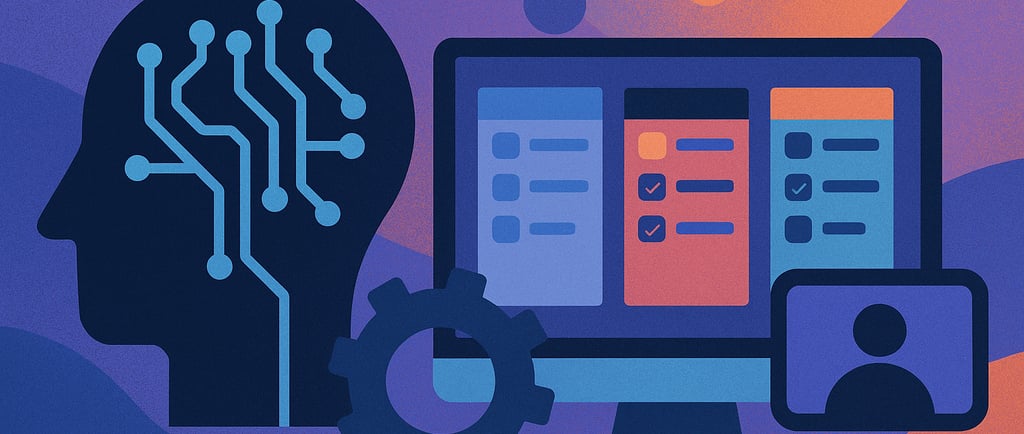The Only Project Management Showdown You Need in 2025
A practical 2025 guide to project management tools: why early-stage teams should stick to Trello or Asana, scaling teams need Jira + Confluence, and career pivoters benefit from mastering both. AI can accelerate workflows, but disciplined processes still win
TECH TOOLS
Alexander Pau
9/8/20254 min read


The Noise in 2025
Everywhere you look: AI this, AI that. Promises of auto-written tickets, predictive deadlines, and sprints that run while you sleep.
I’ve tested a few “AI copilots” inside Jira and Asana. They’re decent. They’ll spit out a backlog faster than an intern. But here’s the truth: if your process is garbage, AI just gives you garbage at scale.
Hybrid work isn’t going anywhere. Some people are back in offices, others fully remote, and some a mix. Tools are no longer just task trackers—they’re proof you’re actually working when no one sees you at a desk. As Gartner’s 2025 hybrid work report shows, teams that thrive centralize communication and document everything.
Then there’s tool overload. I’ve talked to founders juggling six platforms at once: Jira for dev, Asana for ops, Trello for marketing, Notion for docs, Slack for chatter, Google Sheets for… everything else. More apps ≠ more clarity.
Let’s focus on the four names that matter in 2025: Jira, Confluence, Trello, and Asana. I’ve used all of them—from healthcare management to startup ops—and here’s what works.
The Contenders
Jira
The heavyweight. Still the king for dev and product teams.
Jira is clunky. Setting up your first workflow can make you question your life choices. But once you get past the pain, it scales beautifully. Recruiters ask if you know Jira, not Trello, for a reason.
In 2025, Atlassian baked in AI tricks: auto-grooming backlogs, predicting sprint velocity, even suggesting tickets—read Atlassian’s guide to AI in Jira for details. Helpful, but only if your team already has discipline.
For founders: don’t bother until you have product-market fit. For career pivoters: learning Jira makes you instantly marketable.
Confluence
Nobody gets excited about Confluence. But without it, Jira is half-useless.
This is where the real knowledge lives: meeting notes, SOPs, decisions—the messy stuff Slack buries. Hybrid teams thrive when information is centralized, just like I argued in Why Servant Leadership Is the Only Kind That Actually Works. AI can summarize Zoom calls and draft SOPs, but if it doesn’t land in a central space, it’s noise. Confluence is that space.
I’ve used Confluence to set up onboarding guides and recurring SOPs. Not glamorous, but it saved hours of repeating myself. That’s the point: documenting knowledge is how hybrid teams survive and scale.
Trello
The entry drug.
Trello was my go-to when I started Sharp Starts. Content calendars, small projects, even tracking my boxing sessions. It’s visual, fast, and intuitive. Anyone can use it in 10 minutes.
Small teams or solo hustlers can get surprisingly far with Trello, especially if they follow lightweight strategies for focus and visibility—like this Trello productivity guide suggests. AI can auto-create cards from emails or Slack messages, which is slick—but dependencies and scale quickly break Trello’s charm.
Asana
The middle child. Not too heavy, not too light.
Asana shines for cross-functional teams. Marketing, ops, product-light teams—this is your sweet spot. Jira would be overkill; Trello too thin.
The big upgrade in 2025 is AI prioritization. It flags bottlenecks before they burn you. Hybrid teams love it because nobody wants to manually sort through hundreds of tasks just to guess what’s urgent. For career pivoters: Asana is versatile, friendly, and won’t scare you off day one.
The Trends That Actually Matter
1. AI Everywhere, But Not Everything
AI is baked into every tool. Jira writes tickets. Trello creates cards from thin air. Asana reorders priorities.
But AI doesn’t fix broken processes. If your team is messy, AI just accelerates the mess. Use AI as an assistant, not a crutch.
2. Hybrid Work Is Permanent
Hybrid is the new normal. Your tools now prove work is happening. Tickets moving. Docs updated. Projects closing.
Pick tools that keep your team visible without endless check-ins. Learn to show presence in tools rather than spamming Slack. Centralized documentation and consistent team processes—like those highlighted in Why Servant Leadership Is the Only Kind That Actually Works—are key.
3. Tool Overload → Consolidation
Too many tools = wasted brainpower. The smartest teams in 2025 aren’t adding shiny new “AI productivity apps.” They’re consolidating.
For dev-heavy teams: Jira + Confluence.
Cross-functional teams: Asana.
Small hustles: Trello.
This aligns with the Buffett-inspired approach in Warren Buffett Recession Strategies: focus on high-ROI tools, cut the noise, and master what you have. Sometimes the best growth move is removing apps, not adding them.
So, Which One Should You Bet On?
Founder at idea stage → Trello or Asana. Keep it light.
Past product-market fit → Jira + Confluence. Heavy, but worth it.
Career pivoters → Jira to get hired, Asana to stay adaptable.
AI won’t choose for you. The winners in 2025 are the ones who pick a stack, learn it deeply, and resist the urge to bolt on every shiny new app.
📚Further Reading
Atlassian State of Teams 2025 – insights into hybrid and engineering team PM tool usage.
Why Servant Leadership Is the Only Kind That Actually Works – centralized knowledge and leadership in hybrid teams.
SEO That Won’t Drain Your Runway – practical tips for solo hustlers and small teams.
Warren Buffett Recession Strategies – focus and efficiency under constraints.
Capterra Project Management Guide 2025 – tool popularity and use-cases for 2025 teams.
TL;DR
Trello and Asana → quick wins for early-stage founders and small teams.
Jira + Confluence → the serious stack once you start scaling.
Career pivoters → learn Jira to get hired, Asana to stay flexible.
AI is everywhere in 2025 but it doesn’t replace PM tools—it just accelerates the disciplined and exposes the messy.
Stop collecting apps. Pick a stack and get good at it.
